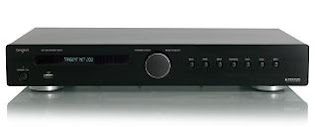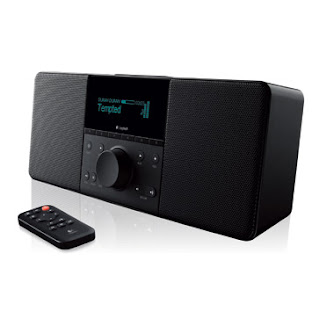-
Digital listening - part 2Having converted some of the family to the pleasure of using a stand-alone device to play internet radio and local music files, the next step was expansion. Putting another device in an area that was not really suited to having a regular computer.
There were a few candidates that seemed to be offering something similar. They are some subtle and not so subtle differences between them (such as whether or an additional application needs to be installed, learned and run to handle core functionality, functionality of the remote control and support for many different formats/protocols for streaming - including the ability to play back material from the BBC Listen Again library).
I had seen a few at CES in 2004 and 2005 and had already been researching.
In general, I discounted devices that could not be controlled from the device (plus its remote control) itself (i.e. if it needed a TV to be on, or if the only way from from a computer).
My shortlist had come down to Sonos, Philips, RokuLabs and SlimDevices (now Logitech).
SonosI decided that although it looked great, it was too expensive for me and did not seem open enough for what I had in mind.

However, I have subsequently recommended it for closer inspection to friends who had both more spare cash than me and less desire to get into the technicalities.
PhilipsThey seemed to have the only device that really was a conventional mini hi-fi system, with CD-player, regular radio and built-in speakers but it was taking forever to come to market in Europe.

When I tried it out at CES I found the menu system too cumbersome and unresponsive - plus the internet radio function seems to only support a "walled garden" approach with no ability for me to enter my own stream URLs, plus there was no support for Microsoft WMA which would have been needed for many internet radio stations. I'm sure that either I was wrong or things have improved since then, but since I could not get my hands on one to experiment with in the UK at that time - I gave it a miss.
RokuLabsI did like the fact that, like the Audiotron, it has a built in filesystem client so that it can play locally held music files without necessarily having to run an extra application.

However, it had no native support for RealAudio format - which meant that I would not have an easy way to listen to the BBC Listen Again material.
Running a connection through a local transcoding proxy could have been one way to do this - i.e. run a local server that can handle RealAudio format and have it translate the data, in real-time to something else. The loss in quality after going through such a translation could be grating, but given the relatively lo-fi that is used for most internet radio then I decided that this need not be a big issue - but I wanted to experiment.
Back then ... the RokuLabs devices included the ability to work with the then current SlimDevices SlimServer. SlimServer was (and still is - but is known as SqueezeCenter nowadays) free to download and use. So I decided to try it out since I would be able to evaluate the free software for use with either vendor.
SlimDevices (now Logitech)As I read more about SlimDevices I was impressed with the approach they were taking.
The user forum was busy and supportive with active engagement by the manufacturer - it was clear that new functions were being added based on user requests. They seem to have put a lot of effort into the audio qualities of the box and had a good looking screen and menu system.

However, it did look like an old-fashioned bedside clock radio (the subsequent SB3 updated the looks, and the later Receiver plus Controller i.e. Duet goes a step further).
But, there was a free download available of a software-only emulation of the Squeezebox.
So - I downloaded the Slimserver and Softsqueeze. I had both up and running in minutes.
It was easy and extend. Softsqueeze allowed me to try out a lot of things, including putting some add-ins in place. It all worked really well.
So - I placed my order for the newly announced SB2 and it arrived direct from USA at the end of March 2005.
It proved so popular at home - that a 2nd followed not long afterwards. Sometimes we set them to synchonise playback so that we can set-up a playlist from the kitchen in the evening and then continue without a break when we eventually arrive in the bedroom.
So I had decided to go with something that seemed to have good basic functions and an active user community who were developing, with the support of the manufacturer, all sorts of interesting add-ons. I did not expect to use many of them (for example showing the scores for sports that I am not interested in) but there were some that looked promising (for example providing the BBC Listen Again content).
It could be argued that having something that seemed to require additional 3rd-party software to achieve what would lead to an overly complex solution and would need a computer to be left on to run it.
Well - I do not have a big concern over something being complex under the covers - provided there is sufficient information and support for those that are willing and able to dabble. If new functions can be added that can then seamlessly appear in the menu at the device so that everyone in the family can quickly understand how to use it if they need it then I'm all for it.
As for running a computer all of the time - although it is not strictly necessary to do this with the Squeezebox
(SqueezeNetwork provides access to internet streams without need of a local server and the device also supports broadcasting a Wake-On-Lan packet to try to restart a slumbering server) ... I already run a PC all day so that it can easily generate the TV and radio listings that I upload for other users of DigiGuide (
I generate programme schedule information for end-users to import into DigiGuide of over 100 stations - maybe that could be the subject of another blog entry).
Next stepsAll of the manufactures featured above have released new models since I was doing my research - and there are other players in the market.
I still had an itch ... I wanted internet radio in the bathroom so that I could listen in while having a long soak. There were numerous possibilities - and apart from kicking myself for not putting some speakers in the ceiling when we had the bathroom refitted ... I was happy to start searching again. Slimdevices/Logitech were steadfastly not making any noise about producing a transportable device with built-in speakers. RokuLabs had finally shipped their SoundBridge Radio and there were other small devices that looked a bit like regular radios that could be interesting. More on this later ...







